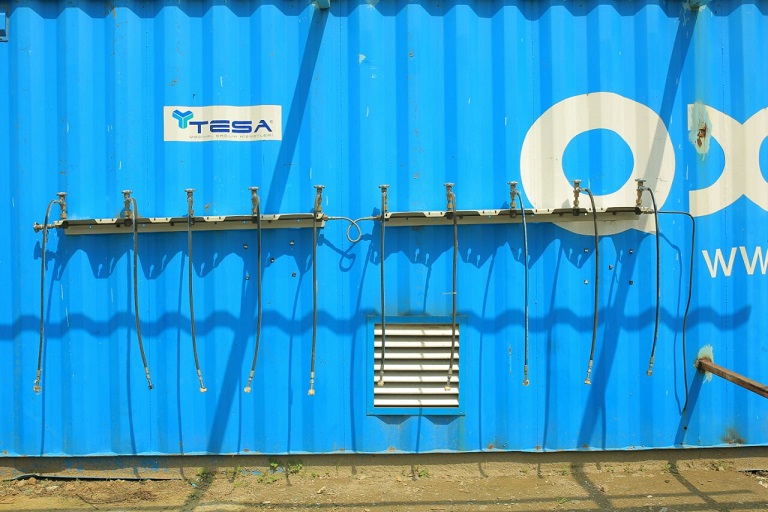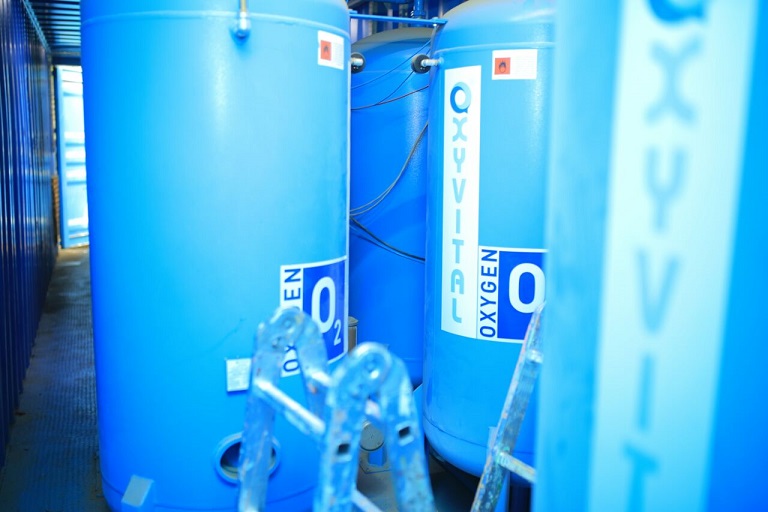The first case of COVID-19 in Ethiopia was reported on March 13, 2020, three days after the World Health Organization (WHO) officially declared COVID-19 a pandemic. The government of Ethiopia responded swiftly. Working through the Emergency Operation Center (EOC), the government set up the Millennium Hall as a COVID-19 makeshift treatment center. It expanded its bed capacity from 360 to 1,000 to deal with the anticipated surge in COVID-19 patients.
With funding from the Gates Foundation, CHAI supported the treatment center with the procurement and installation of a pipeline and manifold system to serve up to 130 beds. We also trained over 2,000 healthcare workers and biomedical engineers to respond to patient needs. This was a critical move to facilitate quality service delivery, minimize re-infection, and reduce the labor costs associated with moving bedside cylinders. At the peak of the pandemic, the existing capacity could meet only 10 percent of the additional demand brought on by COVID-19. There was a need for additional oxygen production capacity, and quickly.
The government of Ethiopia procured two additional oxygen production plants (Pressure Swing Adsorption plants or PSAs), coupled in a duplex configuration, oxygen cylinders, pipelines and manifolds, pulse oximeters, oxygen concentrators, oxygen masks, gas analyzers, and maintenance tool kits. The PSA plants installed at the Millennium COVID-19 Treatment Center provided up to 40-60 percent more oxygen during peak times. During off-peak hours, it provided sufficient oxygen for all patients. Over 7,000 patients admitted during that period were treated. In 2021, 85 percent of patients who had been treated at the center had fully recovered from COVID-19 and were discharged from the hospital.

PSA plant being redeployed to Tikur Anbessa Specialized Hospital (TASH)
Redeploying oxygen equipment
As the pandemic began to abate, the government wanted to reallocate and redeploy the procured equipment to facilities with high oxygen demand. As a trusted strategic and operational partner to the government, CHAI facilitated this process by developing and updating an asset and inventory tracker. CHAI worked with the MOH to define a selection criteria and distribution plan for the facilities that would benefit from this reallocation. However, subsequent waves of the pandemic caused significant delays. Reallocation eventually commenced in a phased manner in July 2022. The government moved the first plant, pipeline and manifold systems from Millenium Hall to Tikur Anbessa Specialized Hospital (TASH). The government then moved the second plant to the UN makeshift hospital/Bulbula COVID-19 Treatment Center for the continued management of COVID-19 cases.
TASH is a high-patient load hospital with a specific focus on maternal and child health services. As the pandemic caseload decreased and the treatment protocol favored the integration of COVID-19 treatment into routine service, in May 2023, the MOH in collaboration with CHAI, moved the second PSA plant to TASH as well. The PSAs moved to TASH significantly narrowed the hospital’s current demand and gap, saving it over 500,000 Ethiopian Birr (US$8,700) per month. This is money that the hospital management would have otherwise spent on procuring oxygen from the private sector. At the end of the redeployment exercise, up to 18 hospitals received equipment, including oxygen cylinders, pulse oximeters, oxygen concentrators, oxygen gas analyzers, and accessories. Both PSAs in TASH were officially commissioned and handed over to the hospital following a full equipment service and training of health professionals.

PSA plant at Tikur Anbessa Specialized Hospital (TASH)
Lessons learned:
- Allocate a budget for equipment redeployment; this will cover technical personnel costs, servicing costs at the new location, procurement of spare parts that may need changing during servicing, and capacity building of healthcare custodians in the new location.
- Use data to inform reallocation and redeployment.
- Robust vendor management and agile procurement approaches are required for the redeployment phase.
Unlocking further investments
The unprecedented procurement of oxygen equipment during the pandemic can now be a lifesaving resource for ongoing health needs. By considering the needs of health facilities and pre-allocating redeployment budgets, we can ensure these valuable resources continue to save lives. The collaborative effort between MOH and CHAI proves that with thorough planning and commitment, we can turn a crisis into an opportunity for sustainable improvement in healthcare infrastructure.
The funding from the Gates Foundation before and during COVID-19 has been instrumental to Ethiopia’s medical oxygen expansion efforts to date. This funding has helped unlock further investments from the MOH and other donors commitments to improve access to medical oxygen and rational use across all regions of Ethiopia.





